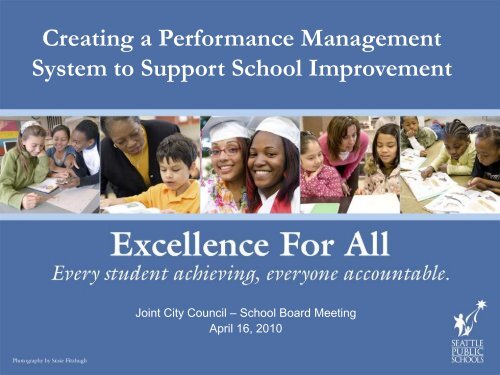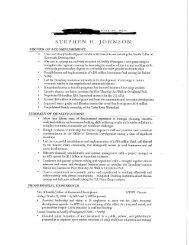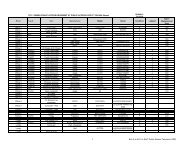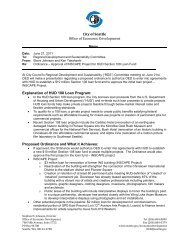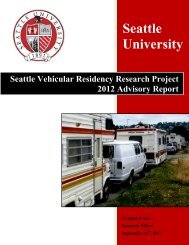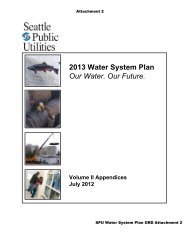Performance Management Presentation for Joint City Council-School
Performance Management Presentation for Joint City Council-School
Performance Management Presentation for Joint City Council-School
Create successful ePaper yourself
Turn your PDF publications into a flip-book with our unique Google optimized e-Paper software.
Creating a <strong>Per<strong>for</strong>mance</strong> <strong>Management</strong><br />
System to Support <strong>School</strong> Improvement<br />
<strong>Joint</strong> <strong>City</strong> <strong>Council</strong> – <strong>School</strong> Board Meeting<br />
April 16, 2010<br />
1
Agenda<br />
• Overview of <strong>Per<strong>for</strong>mance</strong> <strong>Management</strong> framework<br />
• District level goals and annual scorecard<br />
• <strong>School</strong> level goals and annual reports<br />
• Segmenting schools based on per<strong>for</strong>mance<br />
• Providing differentiated responses based on<br />
per<strong>for</strong>mance<br />
2
<strong>Per<strong>for</strong>mance</strong> <strong>Management</strong> Framework<br />
District Level <strong>School</strong> Level Individual/Staff Level<br />
Annual scorecard shows<br />
how the District is per<strong>for</strong>ming<br />
on key academic and<br />
operational metrics<br />
Regular internal reviews of<br />
district departments track<br />
how their work is supporting<br />
district goals<br />
<strong>School</strong> reports (available Fall<br />
2010) will provide a snapshot of<br />
school per<strong>for</strong>mance on common<br />
academic measures.<br />
<strong>School</strong>s will receive differentiated<br />
and targeted supports based on<br />
per<strong>for</strong>mance and need<br />
Teachers are using Measures of<br />
Academic Progress assessments,<br />
which provide real-time in<strong>for</strong>mation<br />
on math and reading per<strong>for</strong>mance.<br />
Perf Mgt Overview<br />
Seattle Public <strong>School</strong>s‟ ef<strong>for</strong>t to define excellence, measure and report<br />
progress, and act based on data is called per<strong>for</strong>mance management. This<br />
work is happening at all levels and involves a number of critical new tools and<br />
processes.<br />
New individual per<strong>for</strong>mance<br />
evaluations are being rolled out<br />
to many central office employee<br />
groups, and additional support<br />
<strong>for</strong> evaluating school-based staff<br />
is now available.<br />
3
Intended Impact of PM<br />
Perf Mgt Overview<br />
• For students, families and the community<br />
– Greater transparency around goals and outcomes/per<strong>for</strong>mance<br />
– Clear areas of focus <strong>for</strong> every school with targeted supports from<br />
the district<br />
• For district staff<br />
– Clear per<strong>for</strong>mance expectations<br />
– Targeted supports to help meet those expectations<br />
– Prescribed set of actions based on per<strong>for</strong>mance and need<br />
• For the community<br />
– Transparency and accountability around per<strong>for</strong>mance goals<br />
• For partners<br />
– Alignment of ef<strong>for</strong>ts toward common student achievement goals<br />
4
District Goals<br />
5
Annual <strong>School</strong> Reports (1/2)<br />
<strong>School</strong> Goals<br />
6
Annual <strong>School</strong> Reports (2/2)<br />
<strong>School</strong> Goals<br />
7
<strong>School</strong> Reports Explained: High <strong>School</strong><br />
What we measure How we measure it Why it is important<br />
<strong>School</strong> Goals<br />
# Students Total number of K-12 students enrolled on October 1 of the respective school year. Provides basic in<strong>for</strong>mation about a school.<br />
# Teachers<br />
Total number of certificated staff in a school on October 1 of the respective school<br />
year.<br />
Provides basic in<strong>for</strong>mation about a school.<br />
# Other Staff Total number of non-teacher staff in a school. Provides basic in<strong>for</strong>mation about a school.<br />
Average Class Size<br />
Average Daily Attendance<br />
Student Mobility<br />
Average class size, where class size is the October 1 enrollment <strong>for</strong> the respective<br />
school year, <strong>for</strong> all scheduled homerooms and classrooms, excluding special ed and<br />
elementary BOCs.<br />
The annual average of all students daily attendance, weighted by the number of<br />
instructional days a student is enrolled at a school.<br />
Number of students that enter and exit a school (excluding graduates) after the<br />
October 1 headcount divided by the October 1 headcount.<br />
Provides basic in<strong>for</strong>mation about a school.<br />
If students do not attend school, they are unlikely to learn and more likely to drop<br />
out.<br />
Transferring schools during a school year can be very challenging <strong>for</strong> a student and<br />
have a negative impact on their academic achievement.<br />
Students making gains on the<br />
state reading and math tests<br />
% of students at or above the 50th percentile of growth from year to year on the<br />
WASL using the Colorodo Growth Model. The Colorado growth model estimates a<br />
"growth percentile" <strong>for</strong> each student with two years of test data by creating a peer<br />
group of all students the same grade who had the same WASL score the previous<br />
year and rank this group of students by their WASL scores in the current year.<br />
All students should be making progress every year and be on their way to meeting or<br />
exceeding standards<br />
English Language Learners<br />
making gains on the state<br />
proficiency test.<br />
First-time 9th graders earning<br />
sufficient credit<br />
Repeat 9th graders earning<br />
sufficient credit<br />
10th graders proficient on the<br />
state reading, math, writing, and<br />
science tests<br />
Students graduating in 4 years or<br />
fewer; in 6 years or fewer<br />
Graduates prepared <strong>for</strong> a 4 year<br />
college<br />
Graduates enrolling in higher<br />
education within 1 year<br />
% of English Language Learner students with two consecutive years of results<br />
moving up a level from year to year on the state ELL WLPTII test of english<br />
language proficiency<br />
% of 9th graders who earn 5 credits in their first year in high school – enough to be<br />
promoted to 10th grade.<br />
% of repeating 9th graders who earn 5 credits in their most recent year in high<br />
school – indicating that they are earning enough credits to get back on track.<br />
% of 10th grade students who earn scores on the state WASL test at or above the<br />
cutoff the state defines as "meeting standard"<br />
% of students who graduated within 4 / 6 years of starting high school. For a<br />
particular school year these measures reflect two different cohorts of students: one<br />
that started 4 years earlier and one that started 6 years earlier.<br />
To be determined pending further review and completion of high school alignment<br />
work.<br />
% of the prior year's graduating students who have entered 2-year or 4-year colleges<br />
or public technical programs in the year after graduating<br />
English language proficiency is an important skill that our schools should be<br />
supporting in all students<br />
We want to make sure 9th graders succeed and don't need to repeat 9th grade,<br />
which leads to many of them dropping out of school<br />
<strong>School</strong>s need to support students in getting back on track if they fall behind<br />
These are tests that show how a student is doing on Washington's academic<br />
standards. Every student should meet standard to succeed in high school and<br />
beyond.<br />
At a minimum, all students should graduate from high school; they should not drop<br />
out.<br />
Students are much more likely to succeed if they attend college or training after high<br />
school. They should finish high school ready to learn and succeed in college and<br />
career.<br />
We want to be sure students enroll in higher education or career training after high<br />
school.<br />
Students taking college<br />
admissions tests<br />
% of 12th graders who have (at some point during high school) taken either the SAT<br />
test or the ACT test used <strong>for</strong> college admissions<br />
Taking the SAT or ACT test and earning a good score is another way we get<br />
students ready <strong>for</strong> success after high school.<br />
8
Using <strong>Per<strong>for</strong>mance</strong> Data to Segment <strong>School</strong>s<br />
• Segmentation is the grouping of schools by both<br />
absolute and growth per<strong>for</strong>mance.<br />
• The purpose of segmenting schools is three-fold:<br />
– To provide a consistent way of looking at school<br />
per<strong>for</strong>mance across the system<br />
– To give a framework <strong>for</strong> how central office should<br />
differentiate interventions and support<br />
– And to provide transparency and accountability to the<br />
public on school per<strong>for</strong>mance and district responses<br />
<strong>School</strong> Segmentation<br />
9
Growth <strong>Per<strong>for</strong>mance</strong> Index<br />
Growth <strong>Per<strong>for</strong>mance</strong> Index<br />
Segmentation is the grouping of schools<br />
By absolute per<strong>for</strong>mance and growth per<strong>for</strong>mance<br />
<strong>School</strong> Segmentation<br />
100<br />
90<br />
80<br />
70<br />
60<br />
100<br />
90<br />
80<br />
70<br />
60<br />
High Growth<br />
50<br />
50<br />
40<br />
Level 1 Level 2 Level 3 Level 4<br />
40<br />
Medium Growth<br />
30<br />
30<br />
20<br />
10<br />
20<br />
10<br />
Low Growth<br />
0<br />
0<br />
0 10 20 30 40 50 60 70 80 90 100<br />
Absolute <strong>Per<strong>for</strong>mance</strong> Index<br />
0 10 20 30 40 50 60 70 80 90 100<br />
Absolute <strong>Per<strong>for</strong>mance</strong> Index<br />
<strong>School</strong>s earn Absolute Points<br />
(Horizonatal Axis) <strong>for</strong> each metric<br />
based on how close they are to 2013<br />
district-wide goals<br />
<strong>School</strong>s earn Growth Points<br />
(Vertical Axis) <strong>for</strong> each metric based<br />
on test score gains and rate of<br />
improvement toward 2013 goals<br />
10
Segmentation Methodology<br />
<strong>School</strong> Segmentation<br />
11
Creating an Accountability Framework<br />
Based on <strong>Per<strong>for</strong>mance</strong><br />
• <strong>School</strong>s receive different levels of autonomy or oversight from<br />
the district based on segmentation and need.<br />
• <strong>School</strong>s that are higher-per<strong>for</strong>ming and show more growth<br />
have greater autonomy over:<br />
– Selection of interventions<br />
– Professional development<br />
– Setting school planning goals<br />
– Discretionary spending<br />
Different. Responses<br />
• <strong>School</strong>s that are lower-per<strong>for</strong>ming and show less growth<br />
receive more oversight from the district depending on actual<br />
per<strong>for</strong>mance and need.<br />
12
Differentiated Interventions – Levels 1&2<br />
Overall<br />
Absolute<br />
Low<br />
Medium-<br />
Low<br />
Overall<br />
Growth<br />
Low-to-<br />
Medium<br />
Low-to-<br />
Medium<br />
Other<br />
Criteria<br />
SPS Accountability Framework<br />
→ Segment = Level of Autonomy or Oversight<br />
--- → Level 1<br />
--- → Level 2<br />
Different. Responses<br />
Superintendent takes one or more of the following actions <strong>for</strong> the<br />
school:<br />
•Change school leadership<br />
•Change school staff<br />
•Direct instructional strategies and professional development<br />
•Change curricular materials and or programs<br />
•Conduct regular accountability reviews throughout the year with<br />
the principal, CAO, and EDs<br />
For additional oversight the district may also:<br />
•Conduct full diagnostic to assess needs<br />
•Require support staff to implement district-directed strategies<br />
•Coach leadership, with more frequent ED visits and heavy<br />
progress monitoring<br />
•Close and/or reconstitute the school<br />
District supports and provides resources with oversight through<br />
the following actions:<br />
•Direct all intervention curricula, supplemental materials, and staff<br />
selections<br />
•Direct all PD<br />
•Direct strategies implemented by support staff<br />
•May conduct full diagnostic to assess needs<br />
•Coach the principal, with more frequent supervisor visits &<br />
reviews and heavy progress monitoring<br />
13
Differentiated Interventions – Level 3<br />
Overall<br />
Absolute<br />
Overall<br />
Growth<br />
Other<br />
Criteria<br />
Different. Responses<br />
SPS Accountability Framework<br />
→ Segment = Level of Autonomy or Oversight<br />
Low or<br />
Medium<br />
Low<br />
Medium-<br />
High<br />
High ---<br />
--- ---<br />
→ Level 3<br />
following actions:<br />
• Frequent progress monitoring<br />
District supports and provides resources through the<br />
• Conduct diagnostic to assess needs<br />
• Support the principal to identify successful and<br />
→ Level 3<br />
appropriate interventions from district list;<br />
schools submit interventions to the district <strong>for</strong><br />
approval<br />
• Collaboratively determine all non-core PD with<br />
the school<br />
• May direct strategies implemented by support<br />
staff and related PD<br />
14
Different. Responses<br />
Differentiated Interventions – Levels 4&5<br />
SPS Accountability Framework<br />
Overall<br />
Absolute<br />
Overall<br />
Growth<br />
Other<br />
Criteria<br />
→ Segment = Level of Autonomy or Oversight<br />
High --- ---<br />
High --- No FRL Gap<br />
→ Level 4<br />
targeting low-achieving subgroups<br />
• PD addresses low-achieving subgroups<br />
District supports through some autonomy and provides<br />
direction in focusing resources on the education<br />
gap<br />
• District provides guidance <strong>for</strong> student interventions<br />
• <strong>School</strong> establishes regular progress monitoring of<br />
subgroup per<strong>for</strong>mance<br />
• <strong>School</strong> has flexibility <strong>for</strong> non-core PD<br />
• <strong>School</strong> has flexibility <strong>for</strong> determining and directing<br />
new staff to address school challenges<br />
District provides school autonomy <strong>for</strong>:<br />
• Academic and social-emotional interventions<br />
→ Level 5 • Selection of non-core PD plan<br />
• C-SIP goals and planning<br />
• Budget <strong>for</strong> discretionary spending<br />
15
Helping <strong>School</strong>s with Improvement Plans<br />
• Every school must create an improvement plan that<br />
addresses its data<br />
Different. Responses<br />
• <strong>School</strong>s must reference and pull from the intervention framework<br />
• This framework lists strategies in reading, math and socialemotional<br />
health that are research-based, have a track record<br />
of success and that the district can support.<br />
• The framework includes foundational strategies that every<br />
school is expected to employ, as well as targeted and intensive<br />
interventions in each content area.<br />
• Interventions are broken into four categories: Materials,<br />
Instructional Strategies, Use of Time, and Other Resources.<br />
16
Sample Intervention Framework - Math<br />
SPS Targeted Interventions – MATH<br />
Elementary Middle High<br />
Different. Responses<br />
Targeted<br />
Interventions:<br />
For students<br />
who aren‟t<br />
successful with<br />
foundational<br />
strategies<br />
Criteria:<br />
Students below<br />
grade level in<br />
math based on<br />
MSP/HSPE or<br />
MAP results<br />
Materials:<br />
Everyday Math (EDM) and Math<br />
Instructional Guide<br />
EDM Manipulatives and Tools,<br />
and On-line Resources<br />
TI-10 or TI-15 Calculators<br />
EDM On-line Algorithm<br />
Handbook<br />
Singapore or other supplements as<br />
recommended in Math<br />
Instructional Guides<br />
Instructional Strategies:<br />
Workshop Model or Centers using<br />
flexible grouping, explicit minilessons<br />
(based on <strong>for</strong>mative<br />
assessment data), conferring, and<br />
independent work<br />
Co-teaching (ELL or special<br />
education)<br />
Homework Help and tutoring after<br />
school guided by MAP results<br />
Peer tutoring<br />
Materials:<br />
CMP2 and Planning/Pacing Guides<br />
Intensified Math Model<br />
Instructional Strategies:<br />
Intensified Math (double-period,<br />
taught by HQ math teacher who<br />
collaborates with core math<br />
teacher): focused on pre-teaching,<br />
supporting, and accelerating<br />
learning <strong>for</strong> core math class;<br />
growth mindset)<br />
Complex Instruction<br />
Co-teaching (ELL or special<br />
education)<br />
Conferring (teacher with small<br />
group or individual)<br />
Homework Help and tutoring after<br />
school guided by MAP results<br />
Materials:<br />
Key Curriculum Series and Course<br />
Guides and on-line resources<br />
Algebra Lab Gear or Algebra Tiles<br />
TI-84 or Nspire Calculators<br />
Geometer‟s Sketchpad and Fathom<br />
Condensed Lessons<br />
Instructional Strategies:<br />
Complex Instruction<br />
Group Testing and portfolios <strong>for</strong><br />
unit synthesis<br />
Summer support/acceleration<br />
through AYD/MESA; students<br />
placed in Algebra with their<br />
summer teachers<br />
Intensified Algebra, Geometry,<br />
Algebra 2 (Labs or support classes,<br />
double-period, taught by HQ math<br />
teacher who collaborates with core<br />
math teacher): focused on preteaching,<br />
supporting, and<br />
accelerating learning <strong>for</strong> core math<br />
class; growth mindset)<br />
17
Sample Intervention Framework - Math<br />
SPS Targeted Interventions – MATH<br />
Elementary Middle High<br />
Different. Responses<br />
Targeted<br />
Interventions: For<br />
students who aren‟t<br />
successful with<br />
foundational<br />
strategies<br />
Criteria:<br />
Students below<br />
grade level in math<br />
based on MSP/HSPE<br />
or MAP results<br />
Time:<br />
75 minutes per day (within<br />
regularly-scheduled mathematics time)<br />
plus at least 60 minutes available after<br />
school at least two times per week<br />
Other Resources:<br />
Teachers access and incorporate online<br />
EDM resources<br />
Structured common planning time <strong>for</strong><br />
staff in math<br />
Establish frequent progress monitoring<br />
and check-ins on progress between<br />
teachers and principal on targeted<br />
students<br />
Assign district-directed math specialist<br />
or coach to principal and/or teachers to<br />
provide 1:1 support as needed<br />
Teacher training on using <strong>for</strong>mative<br />
data to in<strong>for</strong>m instruction<br />
Infrastructure at district and school<br />
level to support co-teaching and afterschool<br />
support<br />
Time: Extra 50 minutes per day (<strong>for</strong><br />
intensified period); at least 60 minutes<br />
available after school at least two times<br />
per week<br />
Other Resources:<br />
Teachers access and incorporate online<br />
CMP2 resources<br />
Structured common planning time <strong>for</strong><br />
staff in math<br />
Establish frequent progress monitoring<br />
and check-ins on progress between<br />
teachers and principal on targeted<br />
students<br />
Assign district-directed math specialist<br />
or coach to principal and/or teachers to<br />
provide 1:1 support as needed<br />
Teacher training on using <strong>for</strong>mative<br />
data to in<strong>for</strong>m instruction<br />
Infrastructure at district and school<br />
level to support double-periods, coteaching<br />
and after-school support<br />
Time: Extra 50 minutes per day (<strong>for</strong><br />
intensified period); at least 60 minutes<br />
available after school at least two times<br />
per week<br />
Other Resources:<br />
Teachers access and incorporate on-line<br />
Key Curriculum resources<br />
Structured common planning time <strong>for</strong><br />
staff in math<br />
Establish frequent progress monitoring<br />
and check-ins on progress between<br />
teachers and principal on targeted<br />
students<br />
Assign district-directed math specialist<br />
or coach to principal and/or teachers to<br />
provide 1:1 support as needed<br />
Teacher training on using <strong>for</strong>mative data<br />
to in<strong>for</strong>m instruction<br />
Infrastructure at district and school level<br />
to support double-periods, co-teaching<br />
and after-school support<br />
18
Creating a Central Office to Support<br />
Differentiation<br />
• Clarity & Consistency: The district has identified a list of<br />
research-based interventions that SPS is able to support - in<br />
math, reading and social-emotional areas.<br />
– Will remain a “working document” that we continuously refine as<br />
we learn which interventions are most impactful <strong>for</strong> our students<br />
– <strong>School</strong>s with more autonomy will have flexibility to propose other<br />
interventions (except core instructional materials)<br />
• Cross-Functional Teaming: Departments are working<br />
together as „school support teams‟ to provide central<br />
coordination of services to schools (HR, Finance, C&I)<br />
Different. Responses<br />
• Data: Central office is providing schools with data and<br />
analysis to help monitor progress and impact of interventions.<br />
19
Impact of<br />
<strong>Per<strong>for</strong>mance</strong> <strong>Management</strong> Work<br />
• Cultural shift is already underway – school leaders and<br />
central office staff have already shifted thinking to focus<br />
on differentiated responses based on per<strong>for</strong>mance<br />
• Ground is laid – even spelled out in board policy – <strong>for</strong><br />
aggressive moves <strong>for</strong> persistently low-per<strong>for</strong>ming<br />
schools<br />
• Engagement with and outreach to community, school<br />
staff, school leaders, unions and central office<br />
administrators has built common understanding of datadriven<br />
approach and need <strong>for</strong> transparency<br />
– Public and educators expect changes in these schools<br />
Connex. to SIG<br />
20
Questions?<br />
Connex. to SIG<br />
21


